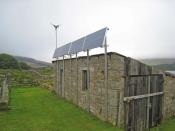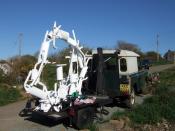Humans have become so dependent on electricity; society's evolution to a great extent has been based on it. Without computers, lights, most methods of transportation and communication, the last hundred years of progress could be set back. Thus electricity could easily be considered man's greatest discovery, it is also generated in such a way that is seriously damaging to the environment.
Oddly enough some of the most commonly used, non-renewable energy sources received their energy in its purest form, as sunlight. Oil, coal, and natural gas are all decomposed ancient organisms. The organisms are all a part of the cycle of life, starting with carnivores (which would have eaten other animals, including herbivores), followed by herbivores (which would have eaten plants), and then plants themselves (which would have extracted their energy from the sun through the process of photosynthesis), the last members of the cycle are decomposers, which are involved after every death, that is they feed off the others.
This means that the true source of most non-renewable energy is one of the most notable renewable sources.
All these non-renewable energy sources plus nuclear (which is not directly linked to the sun, but to unstable nuclei) work in very similar methods to generate electricity. They are used as heat sources, oil, coal, and natural gas are burnt, which heats water placed above, the steam obtained is then used to turn a turbine. The turbine turns a shaft which has wire wrapped around it, this shaft is inside a magnetic field, the movement of the shaft and magnetic field create a current, and thus electricity is generated. Nuclear energy is used in a similar matter, the atoms used, usually uranium-235, is radioactive and thus hot, rods of uranium are placed inside the water, along with control rods, to control the...


